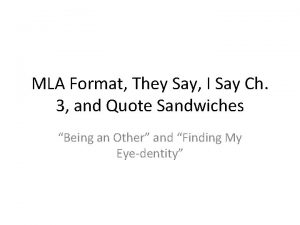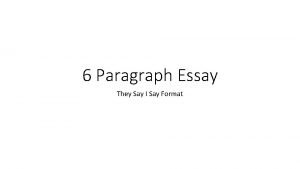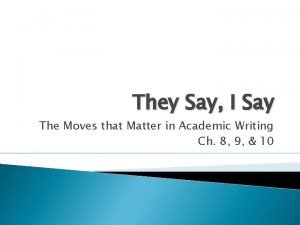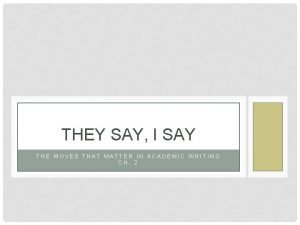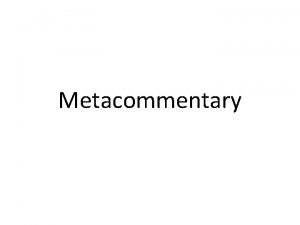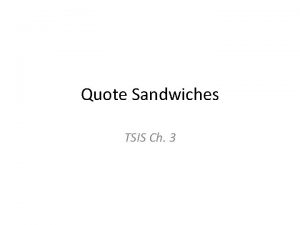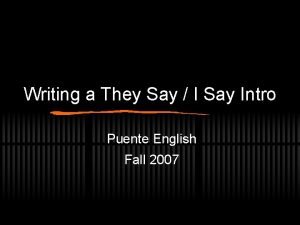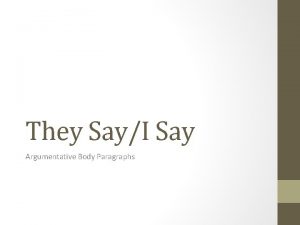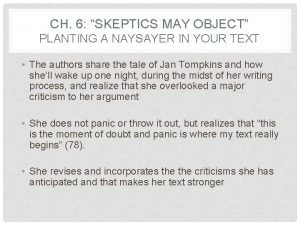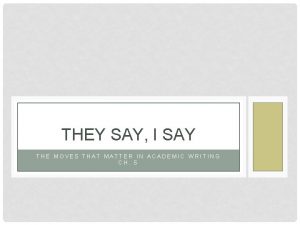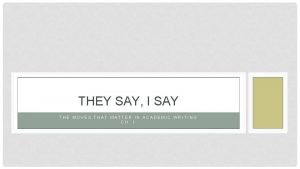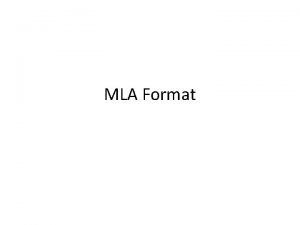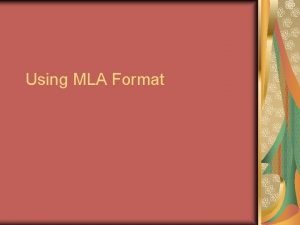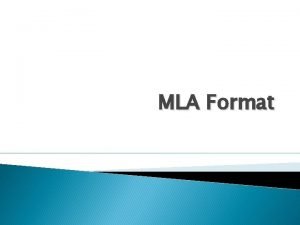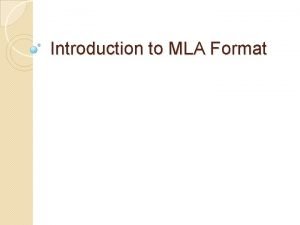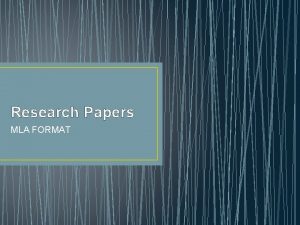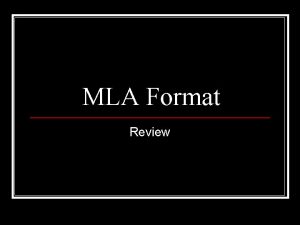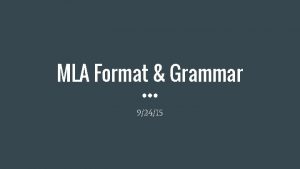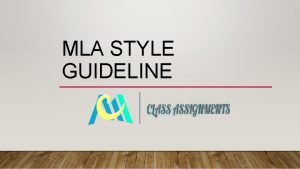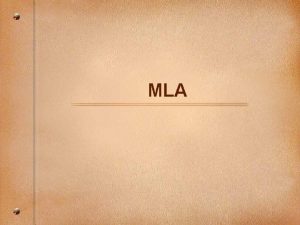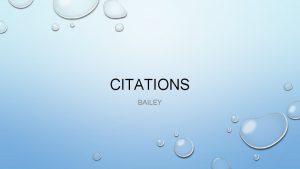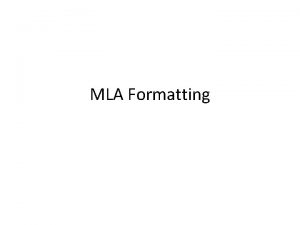MLA Format They Say I Say Ch 3













- Slides: 13

MLA Format, They Say, I Say Ch. 3, and Quote Sandwiches “Being an Other” and “Finding My Eye-dentity”

“Being an Other” p. 144 • What sorts of difficulties (stereotypes, specifically) did Algranati’s parents have to work against in order to be accepted by mainstream American culture? – Discuss Vocab: mainstream • At the end of the essay, how does Algranati define her ethnic culture? • Why might it be important to characterize yourself using this kind of detailed language?

“Finding my Eye-dentity” p. 149 – Identity is constructed, yes—but many people have a more difficult time constructing an identity outside of societies expectations because of physical characteristics that serve as identity markers –identity markers that society often views in a certain way. • What physical characteristic serves as an identity marker in this essay? – Why do you think that this physical characteristic seen as undesirable—even among people/cultures for whom it is common? Can you think of other examples of this?

What Is MLA Format? • MLA Stands for “Modern Language Association” • The MLA makes rules for the writers of research papers in English and the Humanities so that everyone who is doing research is following the same set of rules and we can all understand each other.

What kinds of things do I need to do to have correct MLA Format? • Part of MLA style is format. – – Margins Heading Font, etc. Please see the formatting example that is in the file with your syllabus for my expectations on formatting. • Part of MLA style is citation. – This means giving credit to your sources and avoiding plagiarism. – Citation is also meant to make is easy for your reader find your sources if he or she wishes to read them.

Two Required Ways of Giving Credit in MLA Format – A Works Cited page – Where is it? On its own page at the end of your essay – Lists every source you used in alphabetical order by the last name of the author – Each source on your works cited must contain specific information in a specific order. Consult a handbook or the handout for more details. – Parenthetical (in-text) citations – What is it? A way of indicating which source you just quoted or summarized. – Where is it? In the body (main text) of your essay. – When do I have to use it? • After a direct quote that you took word for word from a source. • After a paraphrase of an idea that you did not write or think of yourself, you must indicate which source you are using in order to avoid plagiarism.

MLA Format • In-text citations and the works cited page work together in order to help your audience know where your quotes or paraphrases came from, and to help your audience easily find the source themselves. • Each in-text citation should use the FIRST name or words that appear in the works cited entry for that source. This way, you are linking your quote to an entry on your works cited page.

Resources for Using MLA • The Purdue Online Writing Lab (OWL) https: //owl. english. purdue. edu/owl/resource/ 747/01/ • Your Rules for Writers text book • Handout posted on the class website

Useful Pages in Your Rules for Writers Book • • • Directory of In-Text Citation examples: p. 458 Directory of Works Cited examples: p. 458 -459 Integrating Sources: p. 468 -479 Avoiding Plagiarism: p. 464 -468 Sample Research Paper in MLA Style: p. 446 -462 Remember, your first essay for English 101 must have a works cited page that cites at least three sources.

Using Sources and Giving Credit • You’ve found your sources, read them, annotated them, and you’re ready to use your sources in your essay. • So… which quotes should you use? – Quotes that contain ideas you want to respond to. – Quotes where the original source’s wording is especially good or important to your response. – Quotes where the original source explains a complex idea clearly and succinctly. – Quotes that contain ideas that would make most people want proof. • Any quote you use should have an explanation/response that is TWICE AS LONG as the original quote. If a quote takes up two full lines of your paper, the explanation/response to that quote should take up FOUR.

They Say / I Say: Chapter 3 • Quotations give your interaction with the ideas of your sources credibility. (p. 42) • Choose quotes that support your claim, and be flexible. This may change as you write. • Frame your quotes. (See how to make a “quote sandwich” on p. 46) • A bad example of how to use a quotation is on p. 45, and the improved example on p. 47.

The “Quote Sandwich” • This is a way to integrate quotes into your paper smoothly and avoid drop-in quotes. • The first piece of “bread” – Introduce quote, possibly mention author, connect quote to what you were saying before. • The “Meat” – Your quote, correctly cited with in-text citation. • The second piece of “bread” – Interpretation/explanation of quote (NOT simply rewording the quote), connect quote to what you will say next.

Quote Sandwich Practice • You are going to write TWO quote sandwiches today. You may use templates from They Say, I Say if you would like to do so. Both quote sandwiches require you to pick a specific quote from a reading and respond to it in the second piece of “bread. ” • Quote Sandwich #1: Practice with a quote from one of the essays we read for today. Introduce the quote, giving appropriate context for an audience who has not read the essay, quote the essay, and respond to the essay. • Quote Sandwich #2: Choose an intriguing, relevant quote from one of the sources you have chosen for your first essay and use it to make a quote sandwich.
 Quotation sandwich they say i say
Quotation sandwich they say i say They say i say format
They say i say format They say examples
They say examples Peter elbow believing game summary
Peter elbow believing game summary They say i say chapter 10
They say i say chapter 10 They say i say gerald graff
They say i say gerald graff Quote sandwich examples
Quote sandwich examples They say i say thesis
They say i say thesis They say i say paragraph examples
They say i say paragraph examples Planting a naysayer in your text
Planting a naysayer in your text They say i say
They say i say Voice markers they say i say
Voice markers they say i say As he himself puts it the art of quoting summary
As he himself puts it the art of quoting summary They say, i say examples
They say, i say examples
